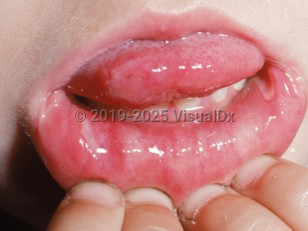There are 3 morphologic types:
- Minor aphthae (Mikulicz aphthae, representing about 80% of cases) are single or multiple lesions, 1.0 cm or less in diameter, and mildly painful; they heal within 1-2 weeks without scarring. They favor the buccal mucosa, labial mucosa, and the floor of the mouth. Onset is typically around the age of 5 years.
- Major aphthae (Sutton disease, representing approximately 10%-15% of cases) are deep ulcers that are 1-3 cm in diameter. These lesions are extremely painful, last from 2-6 weeks, and generally heal with scarring. They favor the labial mucosa, soft palate, tongue, or pharynx. Systemic symptoms, such as fever and odynophagia, may be seen. These lesions begin at the onset of puberty.
- Herpetiform aphthae (representing about 5%-10% of cases) are characterized by multiple oral ulcerations, 1-3 mm in diameter, and have a clinical course similar to minor aphthous ulcers, typically healing in 1-4 weeks without scarring. They can be seen anywhere on the oral mucosa. They have a later onset, usually in adulthood, and are primarily seen in women.
There are 2 well-recognized patterns for recurring oral ulcerations:
- Simple aphthosis is primarily marked by minor aphthae that recur intermittently with disease-free intervals of weeks to months. Patients are generally young and healthy, with lesions limited to the mouth and no underlying systemic disease. Patients frequently report a family history of oral ulceration. In addition to presumed genetic risk, epidemiologic studies (and patient reports) support an association between new lesions and oral trauma, chemical irritation, emotional stress, and smoking cessation. Pregnancy and hormonal changes in menses appear to increase risk. Some studies suggest that those who were breast-fed as infants may be at decreased risk. Most affected individuals experience less severe and fewer episodes after 50 years of age.
- Complex aphthosis is marked by the near-constant presence of 3 or more oral and/or genital aphthae. When genital ulcers are involved, complex aphthosis is sometimes called Lipschütz disease. Complex aphthosis usually occurs in the presence of an underlying disease such as human immunodeficiency virus (HIV), gluten-sensitive enteropathy, inflammatory bowel disease, or Behçet disease. By definition, Behçet disease is accompanied by other findings, including genital ulcers, uveitis, and other skin and systemic inflammatory processes. Complex aphthosis is also seen in rarer conditions such as MAGIC syndrome (mouth and genital ulcers, inflamed cartilage), PFAPA syndrome (periodic fever, aphthous stomatitis, pharyngitis, and lymphadenopathy), and cyclical neutropenia (fever approximately every 3 weeks, oral ulcers, neutropenia).



 Patient Information for
Patient Information for 
